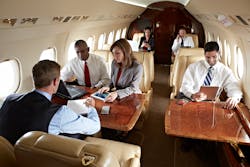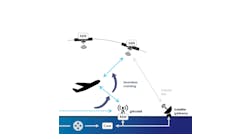What's New in Cabin Communications?
In the world of business aviation, passengers want their office in the sky to be as functional as their regular office, and that requires high-speed internet so they can stay up-to-date on news and emails. So what does the market offer to satisfy today's corporate customer?
One of the most important developments from Gogo occurred in the second half of 2017 when the company announced the Gogo AVANCE platform – a breakthrough combination of hardware and software which is the foundation of all of its new solutions.
Because Gogo AVANCE is software-centric, it enables a new level of remote, cloud-based service and support. In short, AVANCE is the “brains on board” for all of Gogo’s new AVANCE solutions, Dave Mellin, Gogo director of public relations, says.
"With AVANCE, we can now activate and de-activate features remotely – no license keys or onsite support required," Mellin says. "It is how Gogo can offer AVANCE L3 customers the ability to choose from one of three configuration options and give them the ability to transition from one to another at any given time, without the need for someone to physically step into the aircraft. It’s all done remotely. It’s a significant advancement and the platform is scalable."
Gogo has two connectivity systems on the AVANCE platform available today – AVANCE L5 and AVANCE L3. The L3 system is designed for smaller aircraft or for business travelers who simply want email and/or some light web browsing, while L5 is designed for much heavier demand use for larger aircraft with more people onboard. With L5, users can stream video and can utilize other high-bandwidth demand services such as video conferencing. "I’d associate it with L3 being like a 3G experience vs. L5 which delivers a 4G experience to meet needs of a higher volume of customers on an aircraft who want to do more than just email," Mellin says.
Given the slightly smaller size and service plan options, AVANCE L3 is having a higher uptake in the light jet and turboprop segments. "The L3 system comes in a smaller, lightweight form factor, and includes a built-in, advanced 8.0211ac router. It also comes with the most affordable pricing options in business aviation with service levels starting as low as $99 per month. The people who fly those aircraft are generally more cost-conscious and because their missions tend to be shorter, and we find they don’t need to have full-blown connectivity for activities such as streaming video or video conferencing – which is what the L5 can deliver," Mellin says.
"We designed AVANCE L3 to give customers the flexibility to add or reduce system capabilities as their business needs evolve,” Mellin says. “The AVANCE suite of systems has the ability to provide in-cabin services when operating on a satellite network. AVANCE L5 and L3 are designed to operate specifically on Gogo’s ATG network, but they have built-in service that will automatically enable satellite service to be available and will provide in-cabin entertainment through Gogo Vision. Network connectivity will require a separate system. Once Gogo Ku becomes available for business aviation, the AVANCE platform will be the heart of the system that is connecting to the Ku network."
Viasat, a 33-year-old company based in California, got its start in the government/military side. Over 10 years ago it began serving business aviation; and about five years ago it began serving commercial airlines. Overall, it has over 1,100 aircraft that have installed its global satellite solution including military, government, and business jet segments, says James Person, Viasat business aviation business developer director.
As to what's new in 2019, Person says, "Speed, in terms of how fast the internet can be on a business jet. What people want is the same experience as they have in their office, home, or even on some of those airlines that we're serving. Viasat's new thing that we're introducing right now is called Viasat Ka band, and it's significantly different than anybody else's solution out there in that it offers 16 megabits per second to the aircraft. That's the fastest speed today for a business jet for connectivity in the cabin." Midsize and large aircraft can take advantage of Viasat's offering as it has a compact shipipset, at 3 LRUs.
Viasat launched Viasat-1 satellite in 2011, which at the time was the largest capacity satellite in the world, making the Guinness Book of World Records, at 140 gigabits per second. Viasat-2, launched in 2017, doubled its capacity with 260 gigabits per second. The plans for Viasat-3 will be nearly four times larger, at 1,000 gigabits per second, and the company plans to launch three of these satellites. Additionally, Viasat already has four high-capacity Ka-band satellites over North America (Wildblue-1, Anik F2, Viasat-1, and Viasat-2) and jointly own high-speed Ka-band capacity over Europe through a joint venture.
What Are Customers Requesting?
Customers always want more bandwidth and more speed, but they also want to have insight into their onboard system to see how it’s performing: if there are any issues, how much data they’ve used, etc. "We’ve taken that feedback to heart," Mellin says, and "recently launched Gogo DASH which gives flight crews and the aircraft’s home base an insight into both performance and usage. There is the DASH mobile app and a portal for those on the ground. With Gogo DASH, a director of maintenance in the home base can pull up the status of the in-flight entertainment and communications system onboard an aircraft and see the state of connectivity on any or all of the aircraft in his or her fleet, wherever those aircraft might be in the world. Before we released DASH, the director of maintenance would be the last person to know if something had gone wrong during a flight. Now, with DASH, he or she is the first person to know.
"Similarly, our support center can see that something is not right and can get a message straight off to the director of maintenance’s smartphone, keeping that person as well informed, or better informed than the aircraft passengers and crew. DASH enables the director of maintenance to be a lot more proactive, and it saves us significant sums on support. The benefit for the client is that we can get support to them much faster and get their systems back on track."
At the same time, Gogo has field service engineers throughout the United States and Europe, so if something significant goes wrong it does not have to dispatch technicians from Colorado. "Customers have asked for quicker support services and we’re now able to deliver because our technicians are already in-territory and they have flight departments in their locality that they are accustomed to working with," Mellin says. "So they can respond with local knowledge and are very rarely starting from scratch with a client they don’t know. We are expanding our technical teams around the world, focusing on the areas that are home to the highest densities of business jets."
According to Person, Viasat customers are asking for different ways to pay. "Our traditional customer has been a corporate customer and they like to manage their expenses," he says. "They want expenses to be very even throughout the year, but we're seeing charter operators take our system and they want pay-as-you-go type plans. We're seeing a lot of pay-by-the-hour requests now."
Another thing customers request is operational support. "With our fast internet, the engine manufacturer or the aircraft OEM can have data transmitted in real time over our satellite network and they can see anomalies before they happen," Person says. "If they see something going a little bit different, they can have spare parts ready at the next landing site so that a part could be changed out, in some cases, and save time for the passengers, so they don't have an AOG situation.
"If they need to troubleshoot something on the aircraft, we're seeing an increased use of augmented reality," Person says. "With augmented reality, the person wearing the goggles can see what's going on around him or her, along with some additional information. There are some very interesting usage examples that apply directly to business aviation. Let's say you've got an aircraft with a minor problem inflight, or it's on the ground far away from its home base, a pilot or a flight attendant can put these goggles on and somebody at an MRO, or someone in the flight department, maybe the director of maintenance, can walk this person through the equipment area and say: 'Hey, I need to you to look up to the left. See where I'm circling? See that button? I need you to press this button,' and they can circle things through the goggles that the person on the aircraft is seeing. And then they can be their smart hands and make adjustments, reconnect something, take a look at something, or provide the eyes for the director of maintenance who's on the ground. Those are the kinds of challenges that we can solve because we have this high-speed connectivity to the aircraft. It doesn't just serve the passengers in the back. It can serve operational purposes as well."
Another service available is Viasat Unlimited Streaming, where “using whatever your favorite service is you can access Netflix, YouTube TV, or Hulu, any of those services,” Person says. “Passengers can watch live news, their favorite sports team, or financial information, which many of our customers do,” he says, “and it doesn’t count against their monthly data allowance. The movie watching is separate. That is something that we provided as an option, especially because the standard definition TV broadcasts are going away.
“We provide a portal on the aircraft through their own devices, whether it’s through their iPod or their phone, and whatever they watch through that is included in the unlimited streaming service,” Person says.
What Are the Challenges?
Gogo’s goal is to deliver a superior customer experience that is supported by technology, but enhanced with a personal touch, according to. “There are three main areas we’ve focused on to put this into action: the AVANCE platform, enhanced support tools and continued investment in a talented pool of field service engineers,” Mellin says.” We’ve created the AVANCE platform with that in mind. AVANCE is a software-centric solution and is a great example of Internet of Things (IoT) in aviation. What that means to our customers is that that if an issue arises, the AVANCE system self-reports the issue to our technical support team on the ground so we can begin to address and repair any issues before a passenger’s experience is compromised. Already today, more than 15 percent of our customer calls are already being self-reported by the system during flight, and that will only increase in the future.
“We built a lot of capacity into the system that allows us to scale up our customer base without overburdening our support network. And we’ve made huge investments to improve our customer support operations team over the past several years. And we will continue to invest in that area because it’s critical to the overall customer experience.
“I think it’s important to understand the benefits of the AVANCE platform as it’s truly innovative in that it’s a software centric approach vs. a hardware centric approach. What that means is that the AVANCE units are extremely flexible and scalable, even customizable to the user. For example, if you sell an aircraft equipped with L3, the new owner can select the profile they need, no changing out hardware. But the AVANCE platform is an example of IoT in aviation. Did you know one wing of a plane can have up to 10,000 sensors? The challenge is that the data isn’t transmitted. With Gogo AVANCE, sensors in our units are detecting if there are problems “real time” and then send those messages directly to Gogo’s technicians. Our goal is obviously to have no issues, but if there are we want to know about them before they become an issue for the users on the plane.
“With AVANCE we can deliver remote updating/troubleshooting and that is having a big impact on our bottom line because we’re not having to send out a technician at every issue. It’s also having a big impact on the bottom line of our customers because they no longer have to ground an aircraft waiting to get an issue resolved. With AVANCE we often get notification of an issue before the customer is even aware of it, and we’re also able to resolve issues remotely, so it’s faster and more efficient for both parties.
One challenge that Viasat has is helping people understand the Viasat solution. "We have our own Ka satellites but there are other people who have a Ka-band satellite." Person says, "but they are so different than ours that we have to continue to educate people that it's not about the frequency band, it's what you do with it and how it's deployed.
"We have two different solutions, a Ku-band solution and a Ka-band solution,” Person says. “And not only is it our satellite network, but it's our hardware. It's our shipset, as I mentioned, that goes in the aircraft, and we designed the form and fit of our Ku and Ka solutions to be exactly the same. Let's say there's an older aircraft, maybe a Challenger 604, that has our older 3G system onboard. If they take our Ku advance solution off, they can re-fuse the mounting plates, they can re-use the mounting holes, the bolting, and the wiring, and replace it with our Ka solution. We make upgrade from our older Ku solution to Ka very straightforward.
"We provide two different options,” Person continues, “AC power option or DC power option, and different aircraft have different power buses available, or excess of power, either in AC or DC, and so we give them that option. The power interface is pretty straightforward and then from a navigational standpoint, we just take things off the ARINC 429 bus. We get our provisional information that way, and then we just provide an ethernet feed into the cabin. So, they can connect whatever router they want, whatever Wi-Fi equipment. We make it really easy in terms of the interface and the connection.”
The offices in the sky will continue to improve as companies listen to what customers need and stay one step ahead to develop the technology to improve aircraft communication systems.




